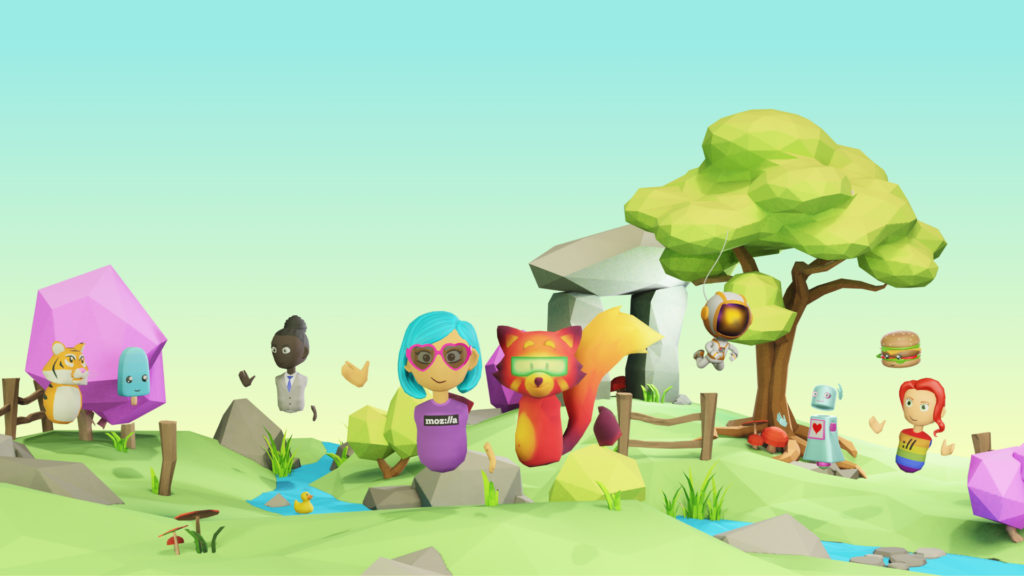Blog Categories
- Appliances Four
- Athletic Seating
- Auto Helpers
- Automated Stock Rooms
- Chocolate Four
- CuraFlo
- Damaged Goods Dating
- Flood Insurance Four
- Game Addict
- Hi Tech Pest Control
- HVAC Four
- Medical Labels Four
- Mental Health Four
- National CWS
- Promotional Ideas
- Seguros Lara Insurance
- Stem Cell Worx
- The Hidden Truth
- The Last Refuge
- The Mozilla Blog
- Video Editing Four
- Web Design Dev
- Website Development Four
- Windows Blog
3 ways to use Mozilla Hubs, a VR platform that’s accessible and private by design

When NASA’s Webb Space Telescope team and artist Ashley Zelinskie wanted to bring space exploration to everyone, they chose Mozilla Hubs, our open source platform for creating 3D virtual spaces right from your browser.
Ashley told us that they “didn’t want to cut people out that didn’t have fancy VR headsets or little experience in VR. … If we were going to invite the world to experience the Webb Telescope we wanted everyone to be able to attend.”
That’s exactly why Mozilla has been investing in the immersive web: We believe that virtual worlds are part of the future of the internet, and we want them to be accessible and safe for all.
That means each Hubs user controls access to the virtual world they created, which is only discoverable to the people they share it with. Hubs users and their guests can also immerse themselves in this world right from their desktop or mobile browser – no downloads or installations required. And while you can use a VR headset, you can access the same spaces through your phone, tablet or desktop computer.
If you’re curious, take a look at a few ways people have been creating immersive worlds with Mozilla Hubs:
To create art galleries and portfolios Credit: Apart Poster Gallery by Paradowski Creative
It’s not just space art. A virtual museum of art prints put together by the creative agency Paradowski helped raise money for a COVID-19 response fund by the World Health Organization. In St. Louis, Missouri, the American Institute of Graphic Arts showcased artists’ work during the school’s annual design show. In the U.K., the Royal Institute of British Architects presented an exhibition that immersed visitors in architectural milestones over the last five centuries.
While Mozilla Hubs can host projects on the grandest scale, you can use it for personal projects too: Whether you’re an artist, photographer or a 3D modeler, you can create an immersive portfolio that’s easy to use and accessible to anybody with a browser.
To build spaces for hobbies (and meet new people) Credit: Mozilla Hubs Creator Labs
The website Meetup lets people find local events based on their interests – from pet poultry to coding to learning a new language. In addition to in-person gatherings, the platform allows people to organize online. Those who wish to meet up virtually can do so in a 3D space through Hubs.
You can create your own immersive space and invite others. You can also just grab an existing room made available by another creator, remix it and make it your own.
To teach and learn
NYU Langone Health, one of the largest healthcare systems in the northeast U.S., uses Hubs to teach anatomy. Hubs helps instructors immerse medical students in the coursework, including 3D vascular stereoscopic models.
Credit: Screenshot courtesy of Dr. Tutaleni Asino
Oklahoma State University’s Emerging Technologies and Creativity Research Lab created a virtual science expo that showcased different Earth environments and hosted Q&A sessions with scientists.
Last week we had the first full VR class on @MozillaHubs at @UCAM Here I would like to share an article describing this exciting experience: https://t.co/nd7ztTx8fC#Innovation #education #Technology #Socialmedia #elearning #Creativity #educationtechnology #edutech #distantlearn pic.twitter.com/4UxB5n0tVv
— Pau Guardiola (@PauGuardiolaNet) July 14, 2020
Olympic medalist Sofía Toro, along with professors from the Universidad Católica San Antonio in Spain, even taught a windsurfing class online using Hubs.
Virtual spaces offer new opportunities for connections and innovation. Through Hubs, Mozilla wants to make those opportunities available to everyone. Learn more and join the Hubs community here.
The post 3 ways to use Mozilla Hubs, a VR platform that’s accessible and private by design appeared first on The Mozilla Blog.
Re Posted From: 3 ways to use Mozilla Hubs, a VR platform that’s accessible and private by design

When NASA’s Webb Space Telescope team and artist Ashley Zelinskie wanted to bring space exploration to everyone, they chose Mozilla Hubs, our open source platform for creating 3D virtual spaces right from your browser.
Ashley told us that they “didn’t want to cut people out that didn’t have fancy VR headsets or little experience in VR. … If we were going to invite the world to experience the Webb Telescope we wanted everyone to be able to attend.”
That’s exactly why Mozilla has been investing in the immersive web: We believe that virtual worlds are part of the future of the internet, and we want them to be accessible and safe for all.
That means each Hubs user controls access to the virtual world they created, which is only discoverable to the people they share it with. Hubs users and their guests can also immerse themselves in this world right from their desktop or mobile browser – no downloads or installations required. And while you can use a VR headset, you can access the same spaces through your phone, tablet or desktop computer.
If you’re curious, take a look at a few ways people have been creating immersive worlds with Mozilla Hubs:
To create art galleries and portfolios Credit: Apart Poster Gallery by Paradowski Creative
It’s not just space art. A virtual museum of art prints put together by the creative agency Paradowski helped raise money for a COVID-19 response fund by the World Health Organization. In St. Louis, Missouri, the American Institute of Graphic Arts showcased artists’ work during the school’s annual design show. In the U.K., the Royal Institute of British Architects presented an exhibition that immersed visitors in architectural milestones over the last five centuries.
While Mozilla Hubs can host projects on the grandest scale, you can use it for personal projects too: Whether you’re an artist, photographer or a 3D modeler, you can create an immersive portfolio that’s easy to use and accessible to anybody with a browser.
To build spaces for hobbies (and meet new people) Credit: Mozilla Hubs Creator Labs
The website Meetup lets people find local events based on their interests – from pet poultry to coding to learning a new language. In addition to in-person gatherings, the platform allows people to organize online. Those who wish to meet up virtually can do so in a 3D space through Hubs.
You can create your own immersive space and invite others. You can also just grab an existing room made available by another creator, remix it and make it your own.
To teach and learn
NYU Langone Health, one of the largest healthcare systems in the northeast U.S., uses Hubs to teach anatomy. Hubs helps instructors immerse medical students in the coursework, including 3D vascular stereoscopic models.
Credit: Screenshot courtesy of Dr. Tutaleni Asino
Oklahoma State University’s Emerging Technologies and Creativity Research Lab created a virtual science expo that showcased different Earth environments and hosted Q&A sessions with scientists.
Last week we had the first full VR class on @MozillaHubs at @UCAM Here I would like to share an article describing this exciting experience: https://t.co/nd7ztTx8fC#Innovation #education #Technology #Socialmedia #elearning #Creativity #educationtechnology #edutech #distantlearn pic.twitter.com/4UxB5n0tVv
— Pau Guardiola (@PauGuardiolaNet) July 14, 2020
Olympic medalist Sofía Toro, along with professors from the Universidad Católica San Antonio in Spain, even taught a windsurfing class online using Hubs.
Virtual spaces offer new opportunities for connections and innovation. Through Hubs, Mozilla wants to make those opportunities available to everyone. Learn more and join the Hubs community here.
The post 3 ways to use Mozilla Hubs, a VR platform that’s accessible and private by design appeared first on The Mozilla Blog.
Re Posted From: 3 ways to use Mozilla Hubs, a VR platform that’s accessible and private by design

